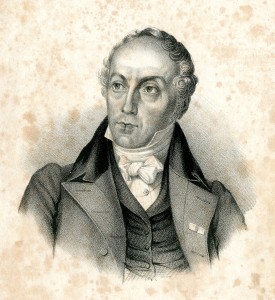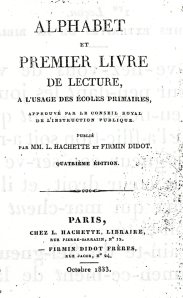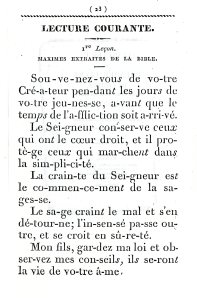When, on October 11th 1832, François Guizot became the seventh Minister of Public Instruction of the July monarchy, he had for a long time been a recognised specialist of education issues. Since 1812, he had been professor of modern history at the Paris Faculty of Humanities, and even his most committed opponents agree that he was the greatest history professor of the first half of the XIXth century in France. Furthermore, with his future wife, Pauline de Meulan, he had founded in 1811 and edited for three years the Annales de l’Education, a monthly publication for families and schoolmasters wishing to receive information about ideas, methods and books necessary to educate children and pupils. Since its foundation in 1815, he had been a member of the Société pour l’instruction élémentaire, which particularly advocated mutual education (the monitorial system), imported from England and very much in vogue at that time. 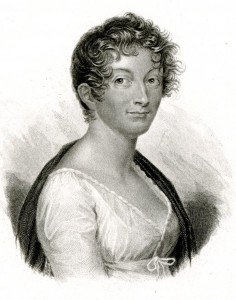 In 1815 also, both as an academic and Secretary General of the Interior ministry, he was the principal architect of the Royal Order of February 17th relating to the reform of Public Instruction. This document, which could not be implemented due to circumstances, contained in 86 articles a complete plan to decentralize and reorganize the University into seventeen academies and recalled in its preamble that “national education’s true purpose is to spread the right doctrines, maintain good moral standards and train men who, through their knowledge and virtues, may channel back to society the useful lessons and wise examples they have received from their teachers”.
In 1815 also, both as an academic and Secretary General of the Interior ministry, he was the principal architect of the Royal Order of February 17th relating to the reform of Public Instruction. This document, which could not be implemented due to circumstances, contained in 86 articles a complete plan to decentralize and reorganize the University into seventeen academies and recalled in its preamble that “national education’s true purpose is to spread the right doctrines, maintain good moral standards and train men who, through their knowledge and virtues, may channel back to society the useful lessons and wise examples they have received from their teachers”.
Above all, to counteract the attacks from the Chambre introuvable (“Unobtainable Chamber”) advocating the control of the Catholic clergy on education, Guizot was led to defend the University and to set out his own ideas in a brochure published in 1816, l’Essai sur l’histoire et sur l’état actuel de l’instruction publique en France, (Essay on the history and the current situation of Public Instruction in France), the first page of which sets out a principle: “the State provides education and teaching to those who would not otherwise receive any, and undertakes to dispense them to those who wish to be its beneficiaries”. Guizot then distinguishes the three levels of teaching – primary, secondary, special – and sets out their content, firstly “the principles of religion and morality”. As the author indeed explains, whereas ignorance “makes the people turbulent and bloodthirsty” as proven by the French Revolution, national education enables the establishment “either between the government and citizens, or between the various classes of society, of a certain confederacy of opinions and feelings which will become a powerful link, a guarantee of calm and an efficient principle of order”. Religion and morality serving the “government of minds” and social order through teaching, sum up the essential elements of Guizot’s actions whilst in power.
So, in October 1832, Guizot was well equipped to occupy 116 bis rue de Grenelle. The central administration of the ministry was lean, consisting of the minister’s office, headed by Alphonse Génie, and his secretariat; three divisions: personnel and administration, divided into five offices, the last of which dealt with Protestant affairs – an innovation; the general accounting and litigation division, with three offices; and finally, the Sciences and Humanities division, directed by Hippolyte Royer-Collard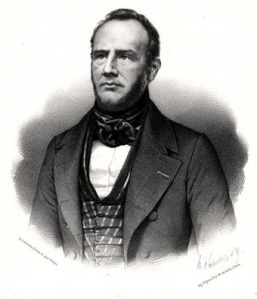 , the nephew of Pierre-Paul, and its two sections. With the two cashiers, there were hardly more than twenty full-time civil servants. It is true that Guizot had recourse to external assistance, such as Charles de Rémusat, deputy for the Haute-Garonne who had been his disciple for fifteen years, or Paul Lorain, who graduated from the Ecole Normale in 1817. Grand master of the University, the minister was also ex officio president of the Royal Council for Public Instruction, which included six other members, including his former and famous colleagues of the Sorbonne under the Restoration, Cousin for Philosophy and Villemain for Humanities, or Ambroise Rendu, who became a much valued assistant. The twelve general inspectors reported to the Council, in addition to the director of the Ecole Normale Supérieure, at that time Guigniaut. The minister devoted considerable attention to personal relations with all those who contributed to the common cause since, he later wrote, “of all the ministerial departments, Public Instruction is perhaps the one where it is most important for the minister to take into account the opinions of those who surround him and to ensure their support in his undertakings (…). In no other branch of government do the choice of men, the relations of the head with his associates, personal influence and mutual trust, play such an important role”.
, the nephew of Pierre-Paul, and its two sections. With the two cashiers, there were hardly more than twenty full-time civil servants. It is true that Guizot had recourse to external assistance, such as Charles de Rémusat, deputy for the Haute-Garonne who had been his disciple for fifteen years, or Paul Lorain, who graduated from the Ecole Normale in 1817. Grand master of the University, the minister was also ex officio president of the Royal Council for Public Instruction, which included six other members, including his former and famous colleagues of the Sorbonne under the Restoration, Cousin for Philosophy and Villemain for Humanities, or Ambroise Rendu, who became a much valued assistant. The twelve general inspectors reported to the Council, in addition to the director of the Ecole Normale Supérieure, at that time Guigniaut. The minister devoted considerable attention to personal relations with all those who contributed to the common cause since, he later wrote, “of all the ministerial departments, Public Instruction is perhaps the one where it is most important for the minister to take into account the opinions of those who surround him and to ensure their support in his undertakings (…). In no other branch of government do the choice of men, the relations of the head with his associates, personal influence and mutual trust, play such an important role”.
Guizot’s task was twofold. Firstly, reestablish primary education in France, which had been seriously neglected by the authorities since the end of the Ancien Régime. Secondly, to implement article 69 of the Charter revised and promulgated on August 14th 1830, which must provide “public instruction and freedom of teaching”. This was part of the broader issue of relations between the State and the Church legally regulated by the Concordat and the organic articles of 1802, but also by specific texts that varied according to the political context. The beginnings of the July monarchy were in fact marked at times by a virulent anti-clericalism, which the Minister of Public Instruction would have to take into account. It remains that, as he had said in a speech in February 1832, “to truly establish a constitutional government, to fight successfully against forces attacking it”, revolutionaries and counter-revolutionaries – “we need the support of religion and of the clergy as a religious establishment”. Guizot made this conviction, as much political as intellectual and moral, the focus of all his actions.
His draft bill on primary education in five sections and twenty-six articles, commenced in October 1832 and presented to the Chamber of Deputies on January 2nd 1833, was well received. This document, as the minister declared, is “essentially practical” and “has really no other purpose than that which it openly proposes, to benefit the education of the people”. The principle of compulsion was not retained even though “a list of children who, since they do not receive primary education at home, must be called to state schools with the authorization or at the request of their parents” had to be drawn up. Nor was the principle of free education, but poor families were exempt from school fees.![]() Concretely, the law stated the minimum and compulsory content of primary, elementary and higher education. It states the principle of the freedom of primary education by the formula “primary teaching is either public or private”. This freedom of choice, as for private schools, is afforded to every person subject to conditions of practice determined by law, i.e. a certificate of competence and a certificate of morality signed by the public authority. State schools are funded by local authorities, departments or the State, each local authority being obliged to fund one primary school with a salaried and housed teacher, and each department a teacher training college. A local inspection committee is responsible for the supervision of state and private schools in its area, and an “arrondissement” committee for all those in its catchment area, this committee being responsible for appointing state teachers from candidates presented by the local committee. Finally, a last article raises the possibility of establishing local girls’ schools, an initiative which was rejected by the Parliament without any real opposition from Guizot.
Concretely, the law stated the minimum and compulsory content of primary, elementary and higher education. It states the principle of the freedom of primary education by the formula “primary teaching is either public or private”. This freedom of choice, as for private schools, is afforded to every person subject to conditions of practice determined by law, i.e. a certificate of competence and a certificate of morality signed by the public authority. State schools are funded by local authorities, departments or the State, each local authority being obliged to fund one primary school with a salaried and housed teacher, and each department a teacher training college. A local inspection committee is responsible for the supervision of state and private schools in its area, and an “arrondissement” committee for all those in its catchment area, this committee being responsible for appointing state teachers from candidates presented by the local committee. Finally, a last article raises the possibility of establishing local girls’ schools, an initiative which was rejected by the Parliament without any real opposition from Guizot.
In total, this short text tended to establish a complementarity rather than a competition between the State and the Church – essentially the Catholic Church – to dispense primary education. The debates ensuing did not give rise to any real fundamental objections since developing primary education was an idea all the more readily accepted than neither the deputies nor most of the voters sent their children to primary schools. Only one important point was hotly debated, and rejected by the commission: the presence by right of a religious minister – Catholic or Protestant – within the local supervisory committee, also made up of the mayor and three municipal councilors. How, Guizot responded, after unanimously accepting in the first article that “ moral and religious education” figures at the forefront of primary education, do you exclude from the supervision of schools “the moral and religious judge” which the Catholic priest or Protestant minister represents in each town or village? And furthermore, if the priest is well-meaning, it will benefit the committee. If he is not, which can happen, it is better to have him on the inside, annihilated by the four lay persons, rather than on the outside where he risks establishing a rival school to the state school which he will denigrate with all his might. If he is excluded by law, all the clergy, the immense majority of whom are right-minded, will be offended. Nevertheless, most of the deputies sided with the commission and it was only during the second reading that the presence of the priest was reestablished in the supervisory committee, whose powers were nevertheless reduced. The left-wing deputy Taillandier exclaimed: “this is a bone of contention that you throw amongst all local authorities if you leave the mayor and the priest to supervise schools simultaneously”. The law, passed on 3rd May by the Chamber in its first reading by 249 votes to 7 was only adopted on 18th June by 219 votes to 57. It was promulgated ten days later.
This text, in itself not that innovative, was the ambiguous fruit of a necessary compromise. This is where the profound cause of its success and its posterity undoubtedly lies. The obligation to open local schools and training colleges, the elevation of the teacher to the dignified position of civil servant appointed by the minister, the recruitment everywhere of schoolmasters acknowledged as competent, the supervision of schools by public authorities, consecrated the State as being responsible for and guarantor of primary education. Nevertheless, even though it was controlled, the freedom to teach was real, even though the State henceforth imposed a competition on private schools that many would find difficult to endure, which Guizot explicitly counted on. The clergy, although not being excluded from the running of state schools, was kept at a reasonable distance while religion within teaching was made the priority.
The application of the law
The law of 1833 did not appear in a void, as a general inspection of all the primary schools launched just after its adoption demonstrated, when 490 people visited 33,456 schools, including 47 teaching colleges, over a four-month period. Paul Lorain drew up a summary in a “Table of primary education in 1833”, an exceptional wealth of information. This success led Guizot to transform primary inspection into a permanent institution in February 1835. Nevertheless a strong impulse had thus been given to primary state education, particularly through the continual increase of financial resources. The state education budget went from 7.8 million in 1832 to 12.4 million in 1835 and reached 19.2 million in 1848. Primary education benefited most from the increase, since its budget went from 1 million in 1832 compared to 1.7 million for secondary education, to 5.9 million against 2.6 million in 1837.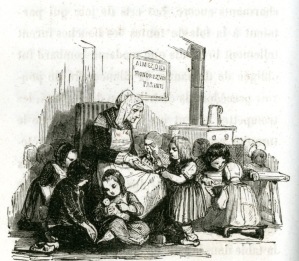 Above all, the application of the law gave rise to a considerable number of circulars, the most famous of which, written by Rémusat, being the one of July 4th 1833 sent to all teachers in France with the text of the law, to explain the spirit and means with which they were to carry out their mission. Another, also dated July 4th, to the rectors and prefects, states that the salles d’asile (the first nursery schools) also fall within the ambit of public instruction, “where small children aged from two to six or seven, too young to go to proper primary schools, shall be received, when their parents, poor and working, do not know how to keep them at home (…). They are the basis and so to speak, the cradle of popular education”. At the other extreme are adult schools, “where the generation already working, already earning a living, may receive the education they missed during their childhood”.
Above all, the application of the law gave rise to a considerable number of circulars, the most famous of which, written by Rémusat, being the one of July 4th 1833 sent to all teachers in France with the text of the law, to explain the spirit and means with which they were to carry out their mission. Another, also dated July 4th, to the rectors and prefects, states that the salles d’asile (the first nursery schools) also fall within the ambit of public instruction, “where small children aged from two to six or seven, too young to go to proper primary schools, shall be received, when their parents, poor and working, do not know how to keep them at home (…). They are the basis and so to speak, the cradle of popular education”. At the other extreme are adult schools, “where the generation already working, already earning a living, may receive the education they missed during their childhood”.
The minister did not only communicate with teachers and those responsible for primary education by means of circulars. As soon as he arrived at the rue de Grenelle, Guizot created a General Manual of primary education, designed to inform teachers and members of local supervisory committees about all issues, methods and publications relating to primary education. He paid close attention to the publication and distribution of textbooks, provided free-of-charge to needy children. In 1833, these children represented on average 23% of primary school pupils, but more than half in some departments.
450,000 copies were thus dispatched to schools in 1833, l’Alphabet et premier livre de lecture, (the Alphabet and the first reading book) whose anonymous author was Ambroise Rendu, heading the list. Guizot’s law soon produced impressive results.
The Report to the King of April 14th 1834 noted 33,695 state primary schools for boys (31,420 in the previous July), 1,650,000 pupils (against 1,200,000) and 62 teacher-training colleges (against 47). At the end of 1847, it was estimated that there were 43,514 schools with 2,176,000 pupils and 76 teacher-training colleges. Furthermore, the standard of teachers, a large number of whom now came from greatly improved teacher-training colleges, seemed to be substantially higher.
Guizot had just as much interest in secondary education, but none of his reform projects came to fruition before the end of the July monarchy. Compared to primary education, the issues were not the same. Whereas in one case, it was necessary to reorganize and extend a teaching system which was recognized as being principally the responsibility of the State, in the other, the system was already legally and socially in existence. The freedom promised by the Charter had yet to be applied, which in fact meant putting an end to the monopoly given to the University in 1808. Guizot in his Memoirs, invented a colourful formula: “I had to introduce freedom into an institution where it did not naturally exist, and at the same time defend that institution against fierce attackers. It was necessary both to preserve its position and open the doors.” The proper solution would have been, he added, to “renounce entirely the principle of the sovereignty of the State, and to clearly adopt free competition between the State and its rivals, secular or ecclesiastic, individuals or corporations”. Politically, he did not have the possibility, or probably the desire, to do so. The difficulties which the debate on the law for primary education had revealed encouraged him to delay this issue. “It is quite deliberately” he told deputies on May 29th 1835, “that I did not ask that this bill (on secondary education) be put before you sooner; it is because the issues related to it are not, in my opinion, sufficiently resolved.” In 1835, according to some estimates, there was one pupil for 493 inhabitants. Most departmental capitals did not have a royal college, i.e. a lycée, (grammar school), such schools being attended by 14,500 pupils, and below that level town colleges, a second type of public establishment, had only 23,700. Private establishments taught slightly more children, 28,000 in institutions and boarding schools, 16,600 in the one hundred and twenty-one small authorized seminaries; i.e. a total of less than 83,000 pupils. They were probably the children of the middle and more particularly of the upper classes, among whom the voters and elected representatives were recruited, and the political and ideological issues were therefore reinforced, or even exacerbated. Could one abandon this young elite to the influence of the Roman church and to the interests of private industry? Should it be accepted that the University, considered by some to be Voltairian, impose upon the young men an irreligious outlook?
The bill proposed by Guizot in February 1836 attempted to satisfy all parties, by maintaining the University, to which he was personally and professionally attached, and by setting up alongside a certain freedom, the exercise of which was subject to strict conditions. The debate on the bill only commenced on March 14th 1837. Lamartine gave a good summary of it in his speech of March 24th: “Some are concerned about this ghost of Jesuitism that is constantly evoked here and which should be declared stronger than ever, if it had the power to make us retreat in the face of freedom. Others seem to fear that the clergy does not have an exclusive hold over the young people and that the spirit of the time represented by the University exercises the monopoly over the traditional and religious element represented by the teaching professions”. It was this twofold dissatisfaction which led the deputy to support “the sincere and courageous minister”. Guizot had, as in 1833, recalled that “everything that is in the general interest, everything that relates to the great moral interests of citizens and families is the responsibility of the State alone”, and that at the same time religion was “the most efficacious means of introducing into souls this interior and moral peace without which you will never re-establish external and social peace”.Through the competition created by the law and which would be imposed upon private institutions, Guizot stated clearly to the deputies that he counted upon “the victory of public establishments, necessary to the interests of society”. This was also the opportunity for the minister to proclaim the primacy of classics over the teaching of science and vocational studies, the development of which was demanded by the Saint-Simonians as well as by scholars such as Arago, or to state firmly that the small seminaries could only exist and receive state aid if they restricted their mission to the training of priests.
The bill was passed on March 29th by 161 votes to 132, a sign of a wavering majority. Two weeks later, Guizot was no longer a minister and the bill, passed at its first reading, disappeared with him. When back in power on October 29th 1840, Guizot, who devoted himself more and more to his department of Foreign affairs, left his Public Instruction colleagues Villemain in 1841 and 1844, Salvandy in 1847, to propose and sometimes debate the bills relating to secondary education without pushing hard for their adoption, which he noted was made impossible by the political situation and the general state of mind. He restricted himself to repeating his great principles, as in his speech of January 31st 1846, loudly applauded but which was not followed up: “The King’s government is firmly resolved to implement the promises of the Charter (i.e. freedom of education). It is firmly resolved to maintain the rights of the State upon state education. It is further firmly resolved to maintain religious peace in the presence of religious freedom and freedom of thought, the coexistence of which honours our society”. However, under the July monarchy, secondary education did not reap the expected benefits from this twofold freedom, contrary to primary education, the progress of which remains associated with François Guizot’s name.
To read more, upload Laurent Theis’ long form of the article in French
